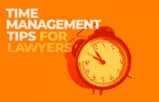All it takes is a quick eye-popping view of Riverview Law’s television campaign to understand the disruptive force of this InnovAction Award-winning U.K. firm. For law firms stuck on the billable hour, it’s likely to be indigestion-inducing. Fixed fees. For everything. Every. Thing. In this week’s Friday Five, Andy Daws, responsible for Riverview’s growing footprint in North America, answers the question, “Wait … they can’t do that, can they?” Lead, follow or get out of the way.
1. How on earth can you make money with fixed fees?
It’s easy! At least, it is if you’re one of the many firms that calculate their fixed fees by multiplying the estimated number of hours by their hourly billing rate and doubling it just in case! (Click here to watch “Cometh the Hour” on YouTube).

2. Aren’t clients suspicious about it?
For years, clients have been held ransom to the billable hour by traditional law firms, many of whom have treated it as a license to print money. Often, clients’ early experience of fixed fees from these same firms hasn’t been terribly positive either. Cynicism abounds and for good reason. But as we’re discovering, if you align your business model to clients’ best interests and then offer fixed fees, that same suspicion doesn’t exist because they can see that the entire enterprise is all about putting the customer first, delivering maximum value and establishing long-term business relationships. It’s not just a veneer to make it look like you’re customer-focused. Traditional law firms offering fixed fees is a bit like splashing a coat of shiny new paint on the exterior of a condemned building — you can call it modernization if you like, but it doesn’t change the fact that the underlying structure is still not fit for its purpose! This is the key — running a fixed fee structure completely changes your business model, operating philosophy and reward and incentive structure.
3. What happens if you miscalculate?
You don’t go back to the client and ask for more money! Nor do you shortchange them by taking shortcuts to reduce your cost base. You take it on the chin, in the context of a long-term business relationship, figure out what you can learn from the experience and move on. Lawyers are typically risk averse and like to see things in black and white. These can be valuable qualities for the practice of law, but they conflict with the fixed fee paradigm, in which there’s often at least a hint of gray. The fragile financial ecosystem most firms inhabit only adds to the problem. But with experience and data, the process becomes more science and less art, and the risk is properly managed. A friend of mine with a solo practice wrestled with these very issues but decided to go out on a limb and offer his services at a fixed fee to one of the largest Internet companies in the world — he landed a sizeable ongoing contract as a result. Fortune favors the brave!
4. How can you possibly know if you’re making or losing money if you don’t have billable hours to track?
Although much revolves around the billable hour within traditional law firms, it’s worth remembering that much of the rest of the world is getting by just fine without it. This is a non-question pretty much everywhere else. Admittedly, once you’ve evolved your business model around the billable hour and chosen to measure and reward success largely by this yard stick, it requires some fundamental changes to reverse out of that cul-de-sac. Such a maneuver will likely be much easier for smaller firms that don’t have the same level of entrenchment. However, it still requires a bold decision and nothing short of reinvention in most cases. At Riverview, our teams do not record their time in the traditional manner, but that doesn’t mean we don’t have a tight handle on all the costs associated with our fixed-fee contracts, because we do. We’re simply looking at the teams’ activities from an entirely different perspective — a business perspective, focused on outputs and value.
5. Can you do this for litigation, too?
Yes, although as you’d expect, it’s sometimes a much more challenging exercise. We do a lot of litigation and we offer fixed fees for all of it — even the major cross-border cases. We just launched a fixed fee M&A offering, too, and are already engaged in our first transatlantic M&A deal. It all comes back to the business model and the data. If you’re caught up in the inputs (hours) and overheads, it’ll drive you crazy trying to figure it out. But when you’re configured for efficiency and have the relevant data at your fingertips, the focus shifts to outputs and value and it’s a different conversation — in fact, a different world. But as long as you’re not looking for a world in which money grows on trees (you won’t find BigLaw here) and don’t mind living with a little ambiguity at times, it can be a great place to be. Clients certainly seem to think so.
Andy Daws is Vice President, North America for Riverview Law (@riverviewlawus), a “new model” firm seeking to change the way businesses use, measure and buy legal services, and widely acknowledged as one of the most innovative law firms in the world. He is a regular speaker on innovation and disruption in the industry, and a guest lecturer at several leading U.S. law schools. Andy is also an adjunct member of the New York City Bar’s Special Committee on International Legal Practice.
Free Download: A New Way to Look at Your Business
Find wit and wisdom on the new legal marketplace in our e-zine: “New Math, New Money: A Lawyer’s Guide to the Changing Business of Law.” As always, it’s free to anyone who subscribes to Attorney at Work!
Illustration ©iStockPhoto.com





















